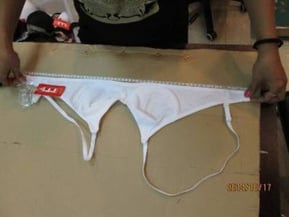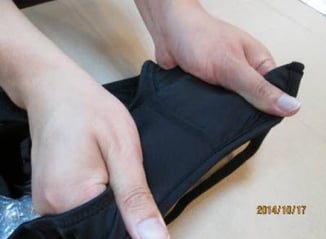The most common reason for fabric breakage on cheap lingerie is the fact that there is no quality control standards set for most cheap lingerie. As a consumer, it is best to check the quality control standards listed above when purchasing undergarments to ensure product reliability and quality.
Though prices for items with quality control standards are much higher than cheap fabrics, high quality garments that are tested are always a better choice. Most quality control standards follow a specific format of inspection process to verify product quality. Here are the most common inspection processes performed on for lingerie today:
Pre-Production Inspection for Lingerie
All of the equipment to be used for cutting, designing, stitching and sewing must be checked for any damages or defects prior to starting with the production queue to ensure that all of the equipment to be used is working as expected. Should there be any materials or equipment that shows signs of damage, these devices will not be used for the whole production process to avoid defective products.
Raw Materials Inspection for Lingerie
Each raw material to be used will be thoroughly inspected for any fabric tear, stretching, slits or any other pre-production anomaly that could take place. The purpose of this inspection process is to verify that all of the materials to be used for assembly are free from any damage or defects to ensure overall product quality.
Craft and Assembly Inspection for Lingerie
All of the undergarments in production will be thoroughly inspected while on the assembly line to ensure that no damages are done while in production such as double stitches, product stacking and other known production anomalies that take place. The purpose of this inspection process is to minimize the errors in terms of design, layering, cutting and other processes done. If there are obvious signs of damage found on lingerie, these undergarments will be marked as “DEFECTIVE” and would not go through the next inspection process.
Visual Inspection for Lingerie
Lingerie that finished production will then be inspected for any signs of damage or defects like garter failure, excessive stitches and other known production anomalies. The purpose of this inspection process is to thoroughly inspect any imperfections seen on the lingerie to ensure that no defective products will pass this queue. Items with defects, regardless of the damage, will be classified under these categories:
- Minor Damage/Defect – items that have loose stitches, exposed garters and other minor issues that can be corrected by sewing.
- Major Damage/Defect – items that fail the necessary requirements in terms of color, design and overall appearance. These items can still be used provided that proper alterations were met.
- Critical Damage/Defect – items that are beyond repair and/or are proven to be hazardous to one’s health and wellbeing.
Sewing Inspection for Lingerie
Products that have undergone visual inspections will then be inspected in terms of how the products are properly sewn. Each undergarment will be thoroughly inspected via the fiber and fabric count of each piece to ensure that all of the undergarments are free from early wear and tear and as well as fabric breakage.
Measurement Inspection for Lingerie
 According to ISO 4416:1981, each undergarment must be thoroughly measured according to its respective product description and specifications to ensure that all of the sizes are uniform and are properly categorized according to shape. Undergarments that are a few centimeters too tight or too loose for its intended size will be considered as defective and will be altered if possible.
According to ISO 4416:1981, each undergarment must be thoroughly measured according to its respective product description and specifications to ensure that all of the sizes are uniform and are properly categorized according to shape. Undergarments that are a few centimeters too tight or too loose for its intended size will be considered as defective and will be altered if possible.
Brasserie Hook Inspection
The purpose of this inspection process is to verify that all of the brasserie hooks for the undergarments are constructed perfectly and are in working order to ensure that all of the brasseries and its mechanisms are measured correctly and working accordingly. All the lingerie that fails this inspection process will be replaced with a new brasserie hook (if necessary).
Final Inspection for Lingerie
All of the undergarments in production will undergo performance and durability tests prior to actual shipping and distribution to ensure that all of the fabrics are in pristine condition prior to distribution. The purpose of this inspection process is to test the undergarments with these tests:
Note: Most of these tests are conducted while the product is submerged in water for accurate analysis.
- Color Analysis – all of the undergarments will be tested as to color accuracy to ensure that all of the products have the same color within their respective categories. Items that have either a fade or damp look will automatically be considered as DEFECTIVE.
- Color Fastness Test – all of the undergarments and lingerie will be put to soaking tests to analyze the color behavior of each undergarment to ensure that no “bleeding” effect will take place after production.
- Elastic Construction Test – undergarments that need garters will be tested under acceptable ranges to ensure that the garters won’t break or weaken after testing.

- Chlorine Bleach Test – lingerie and other undergarments will be tested for cleaning agents such as chlorine bleach to see how the fabrics react to these agents. Items that give out a fade are automatically rejected.
- Anti-Microbial Test – by using state-of-the-art microscopes, all of the undergarments that have been submerged in water will be analyzed for bacteria contamination to ensure that the anti-microbial agents are working as expected.
- Appearance Test – Undergarments of low quality will show wear and tear immediately after initial soak. The purpose of this test is to ensure that all of the undergarments are still in pristine condition even after the numerous tests conducted in water.
Quality Control Inspection of Lingerie
The purpose of this inspection process is to certify that all of the lingerie under production have been thoroughly inspected and tested. Once all of the undergarments that pass the final inspection will be labeled according to the quality control standard it had taken on to ensure product reliability. Items that pass quality control inspection are ready for shipping and distribution.






